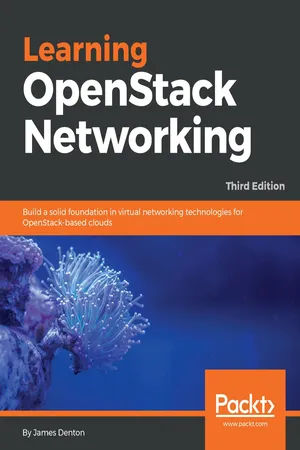
Learning OpenStack Networking
Build a solid foundation in virtual networking technologies for OpenStack-based clouds, 3rd Edition
- 462 pages
- English
- ePUB (mobile friendly)
- Available on iOS & Android
Learning OpenStack Networking
Build a solid foundation in virtual networking technologies for OpenStack-based clouds, 3rd Edition
About This Book
Discover the basics of virtual networking in OpenStack to implement various cloud network architectures
Key Features
- Learn the difference between Open vSwitch and Linux bridge switching technologies
- Connect virtual machine instances to virtual networks, subnets, and ports
- Implement virtual load balancers, firewalls, and routers in your network
Book Description
OpenStack Networking is a pluggable, scalable, and API-driven system to manage physical and virtual networking resources in an OpenStack-based cloud. Like other core OpenStack components, OpenStack Networking can be used by administrators and users to increase the value and maximize the use of existing datacenter resources. This third edition of Learning OpenStack Networking walks you through the installation of OpenStack and provides you with a foundation that can be used to build a scalable and production-ready OpenStack cloud.
In the initial chapters, you will review the physical network requirements and architectures necessary for an OpenStack environment that provide core cloud functionality. Then, you'll move through the installation of the new release of OpenStack using packages from the Ubuntu repository. An overview of Neutron networking foundational concepts, including networks, subnets, and ports will segue into advanced topics such as security groups, distributed virtual routers, virtual load balancers, and VLAN tagging within instances.
By the end of this book, you will have built a network infrastructure for your cloud using OpenStack Neutron.
What you will learn
- Get familiar with Neutron constructs, including agents and plugins
- Build foundational Neutron resources to provide connectivity to instances
- Work with legacy Neutron routers and troubleshoot traffic through them
- Explore high-availability routing capabilities utilizing Virtual Router Redundancy Protocol (VRRP)
- Create and manage load balancers and associated components
- Manage security groups as a method of securing traffic to and from instances
Who this book is for
If you are an OpenStack-based cloud operator and administrator who is new to Neutron networking and wants to build your very own OpenStack cloud, then this book is for you.Prior networking experience and a physical server and network infrastructure is recommended to follow along with concepts demonstrated in the book.
Frequently asked questions
Information
Creating Standalone Routers with Neutron
- Installing and configuring the L3 agent
- Creating an external provider network
- Creating a standalone router in the CLI and Horizon dashboard
- Attaching a router to both external and tenant networks
- Booting instances
- Demonstrating instance and namespace connectivity using Linux bridges
- Demonstrating SNAT and DNAT functionality provided by floating IPs
Routing traffic in the cloud
- qg: Gateway interface
- qr: Router interface

Installing and configuring the Neutron L3 agent
# apt install neutron-l3-agent
Defining an interface driver
[DEFAULT]
...
interface_driver = linuxbridge
[...
Table of contents
- Title Page
- Copyright and Credits
- Packt Upsell
- Contributors
- Preface
- Introduction to OpenStack Networking
- Installing OpenStack
- Installing Neutron
- Virtual Network Infrastructure Using Linux Bridges
- Building a Virtual Switching Infrastructure Using Open vSwitch
- Building Networks with Neutron
- Attaching Instances to Networks
- Managing Security Groups
- Role-Based Access Control
- Creating Standalone Routers with Neutron
- Router Redundancy Using VRRP
- Distributed Virtual Routers
- Load Balancing Traffic to Instances
- Advanced Networking Topics
- Other Books You May Enjoy